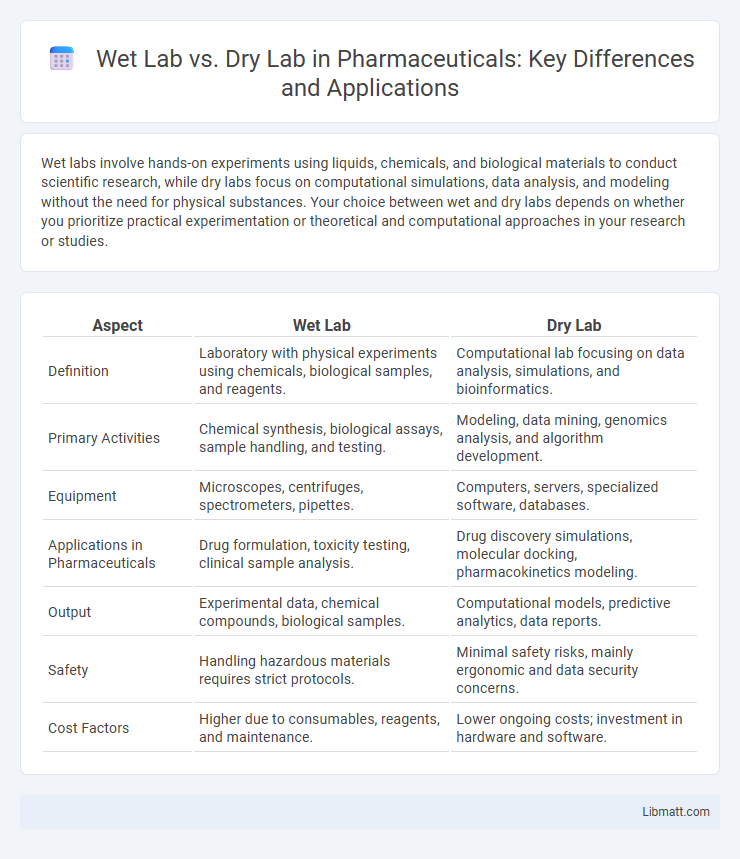Wet labs involve hands-on experiments using liquids, chemicals, and biological materials to conduct scientific research, while dry labs focus on computational simulations, data analysis, and modeling without the need for physical substances. Your choice between wet and dry labs depends on whether you prioritize practical experimentation or theoretical and computational approaches in your research or studies.
Table of Comparison
| Aspect | Wet Lab | Dry Lab |
|---|---|---|
| Definition | Laboratory with physical experiments using chemicals, biological samples, and reagents. | Computational lab focusing on data analysis, simulations, and bioinformatics. |
| Primary Activities | Chemical synthesis, biological assays, sample handling, and testing. | Modeling, data mining, genomics analysis, and algorithm development. |
| Equipment | Microscopes, centrifuges, spectrometers, pipettes. | Computers, servers, specialized software, databases. |
| Applications in Pharmaceuticals | Drug formulation, toxicity testing, clinical sample analysis. | Drug discovery simulations, molecular docking, pharmacokinetics modeling. |
| Output | Experimental data, chemical compounds, biological samples. | Computational models, predictive analytics, data reports. |
| Safety | Handling hazardous materials requires strict protocols. | Minimal safety risks, mainly ergonomic and data security concerns. |
| Cost Factors | Higher due to consumables, reagents, and maintenance. | Lower ongoing costs; investment in hardware and software. |
Introduction to Wet Lab and Dry Lab
Wet labs are research environments equipped with sinks, water, and ventilation systems, allowing scientists to conduct experiments involving chemicals, biological samples, and liquids. Dry labs primarily focus on computational analysis, simulations, and data modeling without handling physical substances. Understanding the differences between these labs helps you choose the appropriate setting for your scientific studies or experimental needs.
Key Differences Between Wet Lab and Dry Lab
Wet labs involve hands-on experiments with chemicals, biological samples, or other physical materials, requiring specialized equipment like fume hoods and safety protocols to manage hazardous substances. Dry labs focus on computational simulations, data analysis, and theoretical modeling without direct contact with physical specimens, utilizing software tools and bioinformatics resources. The key difference lies in wet labs conducting empirical experiments in controlled environments, while dry labs emphasize in silico research and data processing for hypothesis testing.
Core Activities in Wet Lab Research
Core activities in wet lab research involve hands-on experimental work with biological materials, chemicals, and reagents to investigate complex biological processes. Techniques such as cell culture, molecular cloning, enzymatic assays, and microscopy enable researchers to generate empirical data and validate hypotheses. Your ability to manipulate physical samples and observe real-time reactions distinguishes wet labs from dry labs, which focus primarily on data analysis and computational modeling.
Core Activities in Dry Lab Research
Dry lab research primarily involves computational modeling, bioinformatics, and data analysis to simulate biological processes and interpret experimental results. Scientists use software tools and algorithms to analyze large datasets, predict molecular structures, and design experiments. This approach accelerates hypothesis generation and guides experiments conducted in wet labs by providing detailed insights through in silico methods.
Technologies and Tools Used in Each Lab Type
Wet labs utilize technologies such as pipettes, centrifuges, microscopes, and spectrophotometers to conduct experiments involving chemicals, biological samples, and liquids. Dry labs rely heavily on computational tools including software for data analysis, simulation platforms, bioinformatics databases, and high-performance computing clusters to model experiments and analyze large datasets. Integration of advanced robotics and automation systems is increasingly common in wet labs, while dry labs emphasize machine learning algorithms and cloud-based collaboration tools.
Advantages of Wet Lab Approaches
Wet lab approaches enable hands-on experimentation with biological samples, allowing direct observation and manipulation of physical and chemical processes. These methods provide accurate, real-time data on molecular interactions, enzymatic activities, and cellular responses that are often impossible to simulate computationally. Wet labs facilitate innovations in biotechnology, drug development, and diagnostics by delivering empirical evidence critical for validating hypotheses.
Advantages of Dry Lab Approaches
Dry lab approaches offer significant advantages by enabling large-scale data analysis and simulation without the need for physical experiments, reducing costs and time. They provide enhanced reproducibility and scalability through computational modeling and bioinformatics tools, allowing researchers to test hypotheses and predict outcomes efficiently. Your research benefits from faster iterations and the ability to integrate diverse datasets, accelerating scientific discovery in fields like genomics and drug design.
Challenges Faced in Wet and Dry Labs
Wet labs face challenges such as managing hazardous chemicals, ensuring proper ventilation, and maintaining sterile environments to prevent contamination. Dry labs encounter difficulties with data accuracy, computational resource limitations, and integrating complex biological models effectively. Your success depends on addressing these specific obstacles through rigorous protocols and advanced technological infrastructure.
Integrating Wet Lab and Dry Lab Methodologies
Integrating wet lab and dry lab methodologies enhances research accuracy by combining experimental data from physical lab work with computational analysis and modeling. This synergy allows for more comprehensive data interpretation, accelerating hypothesis testing and improving your experimental design. Leveraging both approaches maximizes efficiency and innovation in scientific investigations.
Future Trends in Wet Lab and Dry Lab Research
Future trends in wet lab research emphasize automation, miniaturization, and integration with AI-driven data analysis to accelerate experimental workflows and enhance reproducibility. In dry lab research, advances in computational power, machine learning algorithms, and big data analytics are revolutionizing simulation accuracy and predictive modeling across various scientific disciplines. The convergence of wet and dry lab innovations fosters multidisciplinary approaches, enabling more efficient hypothesis testing, drug discovery, and personalized medicine developments.
Wet lab vs Dry lab Infographic

 libmatt.com
libmatt.com